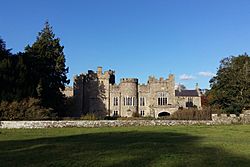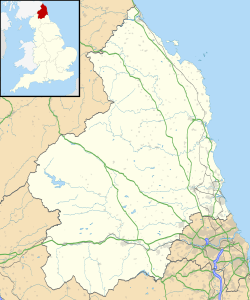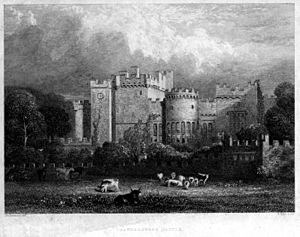Featherstone Castle facts for kids
Quick facts for kids Featherstone Castle |
|
|---|---|
| Northumberland, England | |

Featherstone Castle, 2016
|
|
|
Location in Northumberland
|
|
| Coordinates | 54°56′35″N 2°30′36″W / 54.943°N 2.510°W |
Featherstone Castle is a large, historic country house located in Northumberland, England. It sits right by the River South Tyne, about 3 miles (5 km) southwest of the town of Haltwhistle. This impressive building is known for its Gothic style and is considered a very important historical site.
Contents
A Look Back: Medieval Times
The story of Featherstone Castle begins a long time ago. In the 11th century, a large house called a manor house stood on this spot. It belonged to the Featherstonehaugh family. This area was often a battleground between the English and the Scots, and the castle played a part in these conflicts.
The original building was a hall house from the 1200s. Later, around 1330, Thomas de Featherstonehaugh added a strong, square, three-story tower known as a peel tower. These towers were built to protect people and their belongings during attacks. By 1541, a report said the tower was in good condition and still lived in by Thomas Featherstonehaugh.
Even before the castle, the Romans were here! Around 122 AD, they built Hadrian's Wall, which is about 5 kilometers north of Featherstone Castle.
Changes Over the Years
In the 1600s, Sir William Howard bought the property. He was the father of the first Earl of Carlisle. Sir William made many changes, making the house much bigger and updating its style.
The Featherstonehaugh family bought the house back in 1711. A survey in 1715 described it as "an ancient and well-built structure." The family lived there until Sir Matthew Fetherstonhaugh sold it to James Wallace around 1789. James Wallace's son, Thomas Wallace, made even more changes between 1812 and 1830.
Over time, all these changes turned the castle into a large, complex country house. It has a rectangular shape with a courtyard in the middle and towers at each corner.
Hidden Discoveries and War History
In 1825, farmers near Featherstone Castle found something surprising. They thought it was a buried tree trunk, but it turned out to be an oak coffin with human bones inside! The bones turned to dust when exposed to the air. Four other wooden coffins were found nearby. These "log-coffins" are believed to be from the early Medieval period.
During World War II, a large POW camp called Camp 18 was located near Featherstone Castle. It stretched for about a mile along the South Tyne river. After 1945, this camp held 7,000 German officers. Some parts of the camp can still be seen on the castle grounds today. The camp closed in 1948, and the German officers were sent home.
Featherstone Castle Today
In 1950, the castle was sold and became a boys' preparatory school called Hillbrow School. The school moved to a new location in 1961. After that, Featherstone Castle was changed into a center for young people and students. It now hosts conferences and activities, giving many people a chance to experience this historic place.
See also
 In Spanish: Castillo de Featherstone para niños
In Spanish: Castillo de Featherstone para niños





